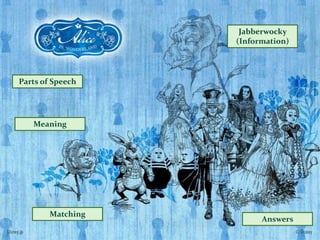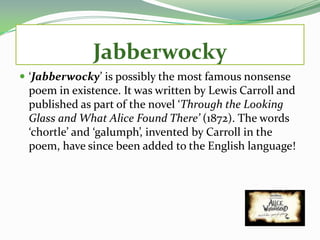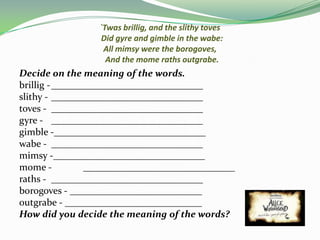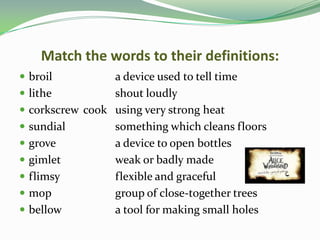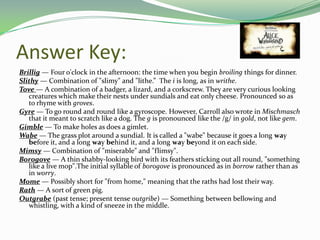Jabberwocky presentation
- 1. Jabberwocky (Information) Parts of Speech Meaning Matching Answers
- 2. Jabberwocky ï âJabberwockyâ is possibly the most famous nonsense poem in existence. It was written by Lewis Carroll and published as part of the novel âThrough the Looking Glass and What Alice Found Thereâ (1872). The words âchortleâ and âgalumphâ, invented by Carroll in the poem, have since been added to the English language!
- 3. `Twas brillig, and the slithy toves Did gyre and gimble in the wabe: All mimsy were the borogoves, And the mome raths outgrabe. Identify the unknown words in the text. What part of speech do you think they are â noun, verb, adjective or adverb? brillig -_________ slithy -_________ toves - ________ gyre - _________ gimble -_________ wabe - ________ mimsy -_________ mome -_________ raths - ________ borogoves - _________ outgrabe - _________ How did you decide what part of speech they were?
- 4. `Twas brillig, and the slithy toves Did gyre and gimble in the wabe: All mimsy were the borogoves, And the mome raths outgrabe. Decide on the meaning of the words. brillig -_______________________________ slithy - _______________________________ toves - _______________________________ gyre - _______________________________ gimble -_______________________________ wabe - _______________________________ mimsy -_______________________________ mome - _______________________________ raths - _______________________________ borogoves - ___________________________ outgrabe - ____________________________ How did you decide the meaning of the words?
- 5. Match the words to their definitions: ï broil a device used to tell time ï lithe shout loudly ï corkscrew cook using very strong heat ï sundial something which cleans floors ï grove a device to open bottles ï gimlet weak or badly made ï flimsy flexible and graceful ï mop group of close-together trees ï bellow a tool for making small holes
- 6. Answer Key: Brillig â Four o'clock in the afternoon: the time when you begin broiling things for dinner. Slithy â Combination of "slimy" and "lithe.â The i is long, as in writhe. Tove â A combination of a badger, a lizard, and a corkscrew. They are very curious looking creatures which make their nests under sundials and eat only cheese. Pronounced so as to rhyme with groves. Gyre â To go round and round like a gyroscope. However, Carroll also wrote in Mischmasch that it meant to scratch like a dog. The g is pronounced like the /g/ in gold, not like gem. Gimble â To make holes as does a gimlet. Wabe â The grass plot around a sundial. It is called a "wabe" because it goes a long way before it, and a long way behind it, and a long way beyond it on each side. Mimsy â Combination of "miserable" and "flimsy". Borogove â A thin shabby-looking bird with its feathers sticking out all round, "something like a live mop".The initial syllable of borogove is pronounced as in borrow rather than as in worry. Mome â Possibly short for "from home," meaning that the raths had lost their way. Rath â A sort of green pig. Outgrabe (past tense; present tense outgribe) â Something between bellowing and whistling, with a kind of sneeze in the middle.

